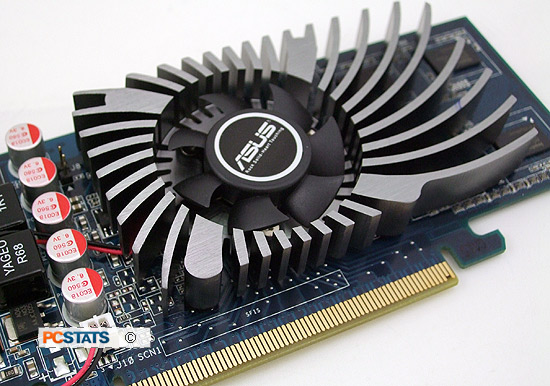nVidia Geforce 9400GT
Technology
The nVidia 'G96' GPU inside the Geforce 9400GT contains
16 stream processors, eight texture units, and eight raster operators. The core
clock for the EN9400GT GPU is 550MHz, and for some reason Asus have paired that
with 1GB of GDDR2 memory running at 800MHz instead of the typical 512MB.
The expanded memory cache likely won't impact
performance by any significant degree. The graphics card is PCI Express x16 2.10
compliant and supports OpenGL 2.1, nVidia Physx, nVidia CUDA, Hybrid Power HD,
Windows Vista's Aeroglass interface and DirectX10 / SM4.0. Translation - this
videocard is suitable for desktop applications but not so much the modern 3D
gaming.

Like most graphics chips of late,
the nVidia Geforce 9400GT will handle dual monitors, and support digital
resolutions up to 2560x1600 and anlog monitors to 2048x1536 pixels. The DVI
ports are dual link, HDCP compliant. On the up side, this GPU is so power
efficient no extra power connectors are required!
 Blu-Ray 1080p High
Definition Content Playback Tests Blu-Ray 1080p High
Definition Content Playback Tests |
With the success of Blue Ray, today's mainstream media center PCs need HD
decoding acceleration like never before. Normally PCSTATS runs these HD playback
tests in our IGP motherboard reviews, like the ASUS M4A78T-E, but today we'll toss them at this
videocard since it is being sold as a quick and cheap way to bring HDMI into an
older media PC system.
Blu-Ray High Definition content demands a lot of PC
processing resources during playback, if CPU load becomes too high that can lead
to jittery video quality or other artifacts. Many integrated graphics processors
now feature Blu-Ray and High Definition H.264, VC1 and M-PEG2 content
acceleration decoders to offload this processing from the CPU, freeing up system
resources for other tasks.
The PCSTATS Blu-Ray HD content playback test scenario
monitors average CPU utilization. Lower CPU utilization values are best,
provided video playback remains smooth and stutter free.
How PCSTATS Tests:
Each IGP graphics chip or videocard is connected to an ASUS MK241 wide
screen 1920x1200 (1080P) resolution LCD display with an HDMI cable.
The Blu-Ray movie "10,000
BC" (VC1 encrypted) is then played back from Chapter 22 on an ASUS
BC-1205PT Blu-ray combo drive, using WinDVD
Platinum software and the average fluctuation of CPU load recorded.
| Motherboard |
Core Logic IGP |
Blu-Ray
Playback
CPU Utilization |
Video Playback
@
1080p Quality |
| Intel DG45ID (Intel G45) |
Intel GMA X4500HD |
32% - 38% |
No issues |
| ASUS P5Q-EM (Intel G45) |
Intel GMA X4500HD |
38% |
No issues |
| Biostar Tpower N750 (nVidia nForce 750a) |
Nforce 750a |
18% - 20% |
No issues |
 ASUS EN9400GT Videocard ASUS EN9400GT Videocard |
Geforce
9400GT |
15-20% |
No
Issues |
| ASUS EAH 4550 Videocard |
AMD HD 4550 |
7% - 10% |
No issues |
| ASUS M4A78T-E (AMD 790GX) |
AMD HD 3300 |
6% - 9% |
No issues |
| ASUS M3A78T (AMD 790GX) |
AMD HD 3300 |
6% - 9% |
No issues |
| Foxconn A7DA-S (AMD 790GX) |
AMD HD 3300 |
14% - 24% |
No issues |
Playback on the Asus EN9400GT was pleasantly uneventful.
The overall system resource usage is well within reason, taking the majority of
video processing load off of the CPU and shunting it onto the GPU. This means
you can get away with a pretty old CPU in your HTPC, provided your video codecs
have support for hardware acceleration.
Hard Drive 720p/1080i Video
Playback
Playing high definition content on current generation
PCs can bog down even the fastest processors because there is more data to
handle. To test the integrated graphics processor's capabilities at HD content
accelerating capabilities, we played the High Definition video clip, "The
Discoverers" at 720P and 1080i from the hard drive while monitoring the
percentage of CPU utilization through Task Manager. Lower CPU utilization is best.
Overall system resource usage is low enough that the CPU
can be doing other tasks while the Asus EN9400GT decodes video. Playing videos
off the hard drive is no more taxing for this videocard than playing video off
of a Blu-ray disc.
